Earlier this month, I set myself on a self-declared journey to research various school systems across the world. My first stop was Finland. The Finnish education system pleasantly surprised me and their practice of teacher training gave me hope. The liberty they bestowed on their students and teachers worked wonders for their growth and economy.
Looking at a similar end-result (Read ‘massive economic growth’) my next stop became Japan, the 11th most populous country in the world.
- The Organisation for Economic Co-operation and Development (OECD) consistently ranks Japan (amongst 34 other countries) the highest position for education and literacy.
- Japanese students score the highest in the OECD’s Program for International Student Assessment (PISA).
With these two statistics in place, it’s hardly a surprise that Japan also has a 100% literacy rate.
How do they do it? Let’s find out!
The School System (Japanese Education System)
Japan revamped its school system after World War II and presently functions on the 6+3+3+4 system. Students spend –
- 6 years in Elementary School,
- 3 years in Junior High School,
- 3 years in High School
- 4 years in University.
By keeping enrollment in elementary and junior high as compulsory for every child, Japan boasts of a 100% enrollment rate. However, the enrollment rate for high school, even though not compulsory is at an impressive 96% across all cities. Interestingly, about 75% of Japan’s high school graduates move ahead of University education.
Operational Analysis:
- An average school day in Japan lasts for 6 hours.
- After school ends, students participate in drills or finish their homework.
- Most students if not all, attend Juku or Cram School that offer further training on academic and non-academic grounds.
- Students do not skip classes nor do they arrive late.
- 6 weeks of summer vacations and 2 weeks of winter vacations are spent learning and completing homework.
- The number of students per class is 40 or less.
- Students are required to learn traditional Japanese arts like Haiku (a form of poetry) or Shodo (a type of calligraphy)
What stands out?
- The first three years spent in elementary school do not focus on the child’s intelligence or learning but on building their characters and teaching them appreciable manners.
- Japanese school system controls individuality and promotes group activity – a majority of the public schools follow a uniform dress code.
- They strongly believe in ‘a class who eats together, stays together’. Students along with their teacher sit together in their respective classrooms and have the exact same meal (which is selected by designed by chefs and nutritionists)
Inside The Mind Of A Japanese Student:
- Japanese students have a strong sense of belonging in their school and don’t feel left out.
- 85% of them have reported being the happiest during school hours.
- Japanese students learn about bonding, team building, and responsibility early on as they clean their schools themselves.
- They conform to the rules and stick by them.
While the Japanese School System may not be as liberal and forbearing as the Finnish, it’s doing remarkably well.
Want to know how?
Answer this quick question – What do Sony, Nintendo, Honda and Canon have in common?
Well, they are all ‘made in Japan’!


